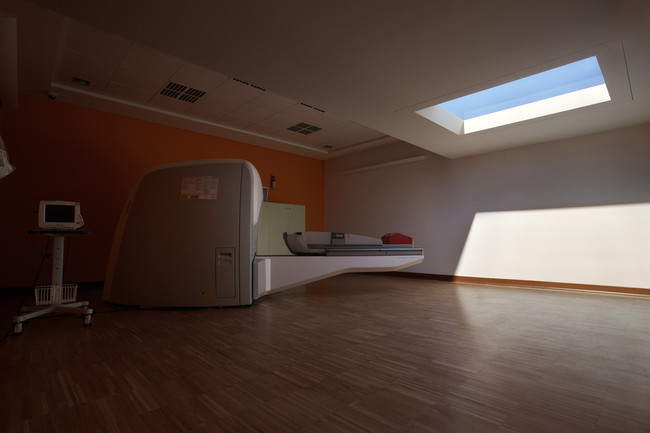
The sense of daylight and shadow was so pervasive at the Milan-based firm Argot ou La Maison Mobile’s exhibition at the 2014 Venice Architecture Biennale, visitors thought that the architects punched skylights through the Arsenale’s historic ceiling. But what appeared to be a brilliantly daylit room was actually an illusion created by a new lighting system that simulates natural sunlight with unprecedented levels of fidelity.
The technology—developed over the last 10 years by Paolo Di Trapani, a physicist at the University of Insubria and founder of the Como, Italy–based CoeLux—comprises skylight- and window-like constructions made up of polymer sheets imbued with LEDs and a thin layer of transparent nanoparticles that simulate the effect of the earth’s atmosphere on sunlight. CoeLux products use a wide range of LED temperatures, from 25,000 kelvin to 3,000K, depending on the model and the preferred lighting effect. The resulting CoeLux panels seem to picture a bright solar disk amid blue sky. This faux sun appears fixed in the sky, as the real sun would, so that one’s movement in a room doesn’t cause it to visibly shift its position.
Di Trapani is quick to note that, unlike similar lighting products, this requires the careful detailing an actual skylight would to be like “a window, a real opening.” His company has worked with Next-Limit Technologies, makers of the Maxwell Render software, to develop a rendering plug-in that replicates the effects of CoeLux for architects to use when designing for unique lighting effects.
The manufacturer recently completed a trial installation in the radiosurgery room at a hospital in Milan. Hospitals, where patients can be confined in windowless rooms for extended periods, are eager to explore the product’s health benefits. To this end, the CoeLux has conducted a two hundred person study–set to be published in next month – with preliminary data suggesting a marked decrease in anxiety for those staying in a small windowless room lit with CoeLux, versus one with the typical fluorescent lighting. Beyond medical applications, Di Trapani says potential applications range from the revitalization of underground spaces to office towers with large floorplates.
Currently, CoeLux is available in three versions, each with a particular light quality and shadow angle: CoeLux 60 reproduces a bright, vertical tropical angle of light with a 60-degree beam; CoeLux 45 mimics a Mediterranean sky with a 45-degree ceiling beam; and the wall-mounted CoeLux 30 simulates a warm Nordic sun with a 30-degree-angle beam relative to the horizon. The first two versions will measure 3.3 by 6.5 feet and the latter will be 3.3 by 5 feet. Prices have not been determined, but may range beyond several thousand dollars. CoeLux is currently undergoing UL safety certification and the manufacturer plans U.S. distribution within several months. There is one caveat: the units need to be deeply recessed to provide the desired illusion. For example, the larger 3.3-by-6.5-foot model would require 3.3 feet of recess while the smaller window requires 2 feet of recess. While Di Trapani acknowledges that this is a challenge, he feels the rewards are worth it. According to him, CoeLux allows architects to “put nature onstage, to play with the sun, the sunbeams, the rays, the shadows, and all color."

Post a comment to this article
Report Abusive Comment